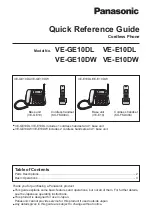
•
Do not put your battery into contact with conductive objects.
•
Dispose of and recycle used batteries in accordance with local
regulations. Do not dispose of batteries by burning; they may explode.
•
Do not use an unauthorized charger.
•
Only use the battery for the device for which it is specified
•
Only use the battery with a charging device that has been qualified with
the device per this standard. Use of an unqualified battery or charger
may present a risk of fire, explosion, leakage, or other hazard.
•
Do not short circuit a battery or allow metallic conductive objects to
contact battery terminals.
•
Replace the battery only with another battery that has been qualified
with the device per this standard, IEEE-Std-1725-2006. Use of an
unqualified battery may present a risk of fire, explosion, leakage or
other hazard.
•
Promptly dispose of used batteries in accordance with local regulations
•
Battery usage by children should be supervised.
•
Avoid dropping the phone or battery. If the phone or battery is dropped,
especially on a hard surface, and the user suspects damage, take it to
a service center for inspection.
•
Use your battery for the specified purpose only.
•
The closer you are to your network’s base station, the longer your
phone usage time because less battery power is consumed for the
connection.
•
The battery recharging time varies depending on the remaining battery
capacity and the battery and charger type you use.
•
Battery life inevitably shortens over time.
•
Use an authorized battery and charger only.
•
Since overcharging may shorten battery life, remove the phone from its
charger once it is fully charged. Unplug the charger, once charging is
complete. Leaving the battery in hot or cold places, especially inside a
car in summer or winter, may reduce the capacity and life of the battery.
Always keep the battery within normal temperatures.
•
To prevent injury or burns, ensure that no metal objects come into
contact with the + and – terminals of the battery.
FCC Regulatory Compliance
FCC Regulatory Compliance
This device complies with Part 15 of the FCC Rules. Operation is subject to
the following two conditions: (1) this device may not cause harmful
interference, and (2) this device must accept any interference received,
including interference that may cause undesired operation.
Your mobile device is a low power radio transmitter and receiver. When it is
ON, it receives and also sends out radio frequency (RF) signals. In August
1996, the Federal Communications Commission (FCC) adopted RF
exposure guidelines with safety levels for mobile devices. Those guidelines
are consistent with safety standards previously set by both U.S. and
international standards bodies: American National Standard Institute
(ANSI), National Council of Radiation Protection and
Measurements(NCRP), and International Commission on Non-Ionizing
Radiation Protection (ICNRP). Those standards were based on
comprehensive and periodic evaluations of the relevant scientific literature.























